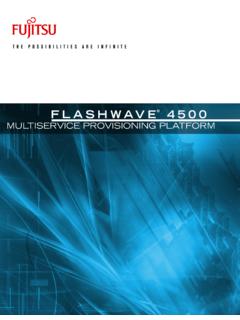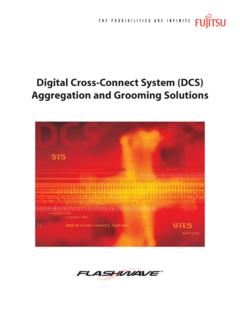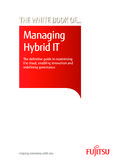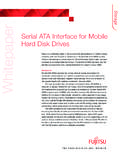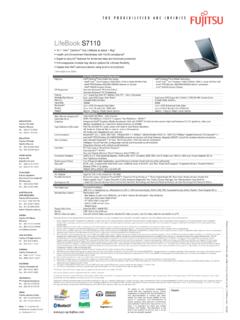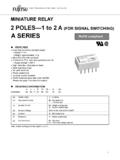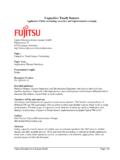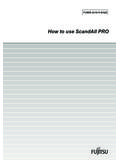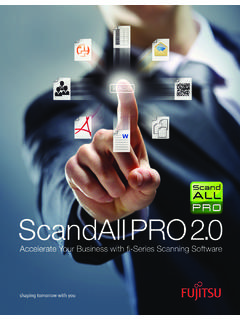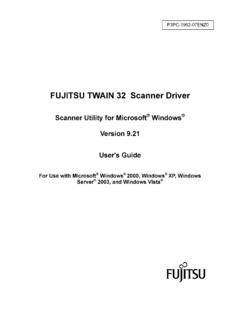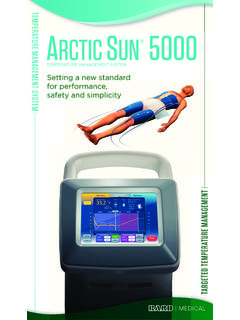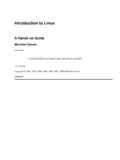Transcription of The TCP/IP Protocol Suite Tutorial - fujitsu.com
1 The TCP/IP Protocol SuiteTutorialDecember 20, 2006 All other products or services mentioned in this document are identified by the trademarks, service marks, or product names as designated by the companies that market those products or services or own those marks. Inquiries concerning such products, services, or marks should be made directly to those companiesThis document and its contents are provided by fujitsu Network Communications, Inc. (FNC) for guidance purposes only. This document is provided as is with no warranties or representations whatsoever, either express or implied, including without limitation the implied warranties of merchantability and fitness for purpose. FNC does not warrant or represent that the contents of this document are error free. Furthermore, the contents of this document are subject to update and change at any time without notice by FNC, since FNC reserves the right, without notice, to make changes in equipment design or components as progress in engineering methods may warrant.
2 No part of the contents of this document may be copied, modified, or otherwise reproduced without the express written consent of and Copyrights Unpublished work and only distributed under restriction. Copyright fujitsu Network Communications, Inc. All Rights Reserved. Microsoft , Windows , Outlook , and Internet Explorer are registered trademarks or trademarks of Microsoft Corporation in the United States and/or other , AOL Instant messenger and AIM are trademarks or registered trademarks of America Online, ! and the Yahoo! logo are registered trademarks of Yahoo, Inc. Acrobat and Acrobat Reader are a registered trademarks of Adobe Systems, , December 20, 2006iTable of ContentsTCP/IP Protocol Suite TutorialFujitsu and fujitsu Customer Use OnlyIntroduction ..1-1 Distribution Method ..1-1 Optional OSI Reference Model ..1-3 Purpose ..1-3 The TCP/IP Protocol We Application Layer.
3 1-8 Application Layer Examples ..1-8 The Transport Layer ..1-9 User Datagram Protocol ..1-9 Transmission Control Protocol ..1-10 The Internet Layer ..1-14 The Internet Protocol ..1-15IP Routing ..1-19 Address Resolution Network Access ..1-25A TCP/IP Networking Interoperability for Microwave Access ..1-40 Frame Relay ..1-44 Asynchronous Transfer Label Switching ..1-52 Tutorial Review ..1-55 Review Answers ..1-59 GlossaryiiRelease , December 20, 2006 List of FiguresTCP/IP Protocol Suite TutorialFujitsu and fujitsu Customer Use OnlyFigure 1-1: The OSI Reference 1-2 Figure 1-2: Comparing the OSI and TCP/IP Models .. 1-4 Figure 1-3: 1-6 Figure 1-4: The UDP Packet Structure .. 1-9 Figure 1-5: TCP Packet 1-12 Figure 1-6: Classful 1-15 Figure 1-7: NAT .. 1-16 Figure 1-8: The IP Packet Structure .. 1-18 Figure 1-9: The Point-to-Point Protocol 1-22 Figure 1-10: Ethernet Frame Formats.
4 1-24 Figure 1-11: PPP Encapsulated in an Ethernet 1-28 Figure 1-12: TCP/IP 1-29 Figure 1-13: Communicating at the Application Level .. 1-29 Figure 1-14: Using TCP to Transport HTTP 1-30 Figure 1-15: Using DNS to Resolve Hostnames .. 1-30 Figure 1-16: Establishing a TCP/IP Connection .. 1-31 Figure 1-17: Invoking the IP 1-31 Figure 1-18: Using ARP to Determine MAC Addresses .. 1-32 Figure 1-19: Using Ethernet to Transmit an IP Datagram .. 1-32 Figure 1-20: Sending the Frame to the Default Gateway .. 1-33 Figure 1-21: Routing the Frame to the Final 1-34 Figure 1-22: The MAC Frame Format .. 1-35 Figure 1-23: WiMAX MAC PDU 1-39 Figure 1-24: Frame Relay Packet Structure .. 1-43 Figure 1-25: ATM Cell Structure .. 1-46 Figure 1-26: Mixed Service Types on an MPLS 1-51 Figure 1-27: The MPLS Label 1-54 Release , December 20, 20061-1 The TCP/IP Protocol SuiteTutorialFujitsu and fujitsu Customer Use OnlyIntroductionThis self-study Tutorial satisfies the prerequisite for Transmission Control Protocol /Internet Protocol ( TCP/IP ) networking knowledge that is required for attendance at fujitsu Network Communications Inc.
5 (FNC) Educational Services data networking product training classes. ObjectivesAfter completing this lesson, the student should be able to: Describe the OSI 7-layer networking model Describe the TCP/IP networking model Define basic networking terminology Understand the various TCP/IP networking components Identify the relationships between the components of the TCP/IP Protocol suiteStandardsThe student can complete the Tutorial and take the self evaluation at the end of the Tutorial . If the student passes the Tutorial , the FNC prerequisite qualification for data networking is complete. If the student does not pass the Tutorial , sections in the Tutorial relating to questions missed should be reviewed. Each student should be familiar with concepts and terms of the Tutorial prior to attending MethodThe data networking Tutorial is available at the following Internet address: Tutorial can be viewed using Acrobat Reader.
6 Optional ReadingFNC-500-0005-010, Guide to ATMATM TutorialEthernet TutorialThe referenced optional reading can be downloaded by going to the following URL: , December 20, 2006 TutorialThe TCP/IP Protocol SuiteFujitsu and fujitsu Customer Use OnlyFigure 1-1: The OSI Reference ModelRelease , December 20, 20061-3 The TCP/IP Protocol SuiteTutorialFujitsu and fujitsu Customer Use OnlyThe OSI Reference ModelAs many networking tutorials do, this one begins with an introduction to the Open Systems Interconnection (OSI) Reference Model (OSI Model). The OSI model is a layered, abstract description for communication and computer network Protocol design, developed as part of the Open Systems Interconnection initiative. It is also called the OSI 7-layer model. PurposeThe OSI model divides the functions of a Protocol into a series of layers. Each layer has the property that it only uses the functions of the layer directly below, and only exports functionality to the layer directly above.
7 A system that implements Protocol behavior consisting of a series of these layers is known as a Protocol stack or simply stack. Protocol stacks can be implemented either in hardware or software, or a mixture of both. Typically, only the lower layers are implemented in hardware, with the higher layers being implemented in LayerThe application layer provides a means for the user to access information on the network through an application. This layer is the main interface for users to interact with the application and therefore the LayerThe presentation layer transforms data to provide a standard interface for the application layer. Encoding, data compression, data encryption and similar manipulation of the presentation is done at this layer to present the data as a service or Protocol developer sees LayerThe session layer controls the connections (sessions) between computers. It establishes, manages and terminates the connections between the local and remote application.
8 Transport LayerThe transport layer provides transparent transfer of data between end users, thus relieving the upper layers from transfer concerns while providing reliable data transfer. The transport layer controls the reliability of a given link through flow control, segmentation/desegmentation, and error LayerThe network layer provides the means of transferring data sequences from a source to a destination by using one or more networks while maintaining the quality of service requested by the Transport layer. The Network layer performs network routing functions, and might also perform segmentation/de-segmentation, and report delivery Link LayerThe data link layer provides the means to transfer data between network entities and to detect and possibly correct errors that may occur in the Physical layer. It arranges bits from the physical layer into logical chunks of data, known as LayerThe physical layer defines all the electrical and physical specifications for devices.
9 This includes the layout of pins, voltages, and cable specifications. 1-4 Release , December 20, 2006 TutorialThe TCP/IP Protocol SuiteFujitsu and fujitsu Customer Use OnlyFigure 1-2: Comparing the OSI and TCP/IP ModelsRelease , December 20, 20061-5 The TCP/IP Protocol SuiteTutorialFujitsu and fujitsu Customer Use OnlyThe TCP/IP Protocol SuiteThe TCP/IP Protocol Suite , also referred to as the Internet Protocol Suite , is the set of communications protocols that implements the Protocol stack on which the Internet and most commercial networks run. It is named after the two most important protocols in the Suite : the Transmission Control Protocol (TCP) and the Internet Protocol (IP).The TCP/IP Protocol Suite like the OSI reference model is defined as a set of layers. Upper layers are logically closer to the user and deal with more abstract data, relying on lower layer protocols to translate data into forms that are transmitted physically over the TCP/IP Protocol is the primary focus of this Tutorial .
10 TCP/IP Model and the OSI Reference ModelThe TCP/IP Protocol Suite was developed before the OSI reference model. As such, it does not directly map to the 7-layer OSI reference model. The TCP/IP Protocol stack has only layers that can be loosely mapped to the OSI Protocol stack, as shown in Figure 1-2. Application LayerThe application layer of the TCP/IP model corresponds to the application layer of the OSI reference model. Some well known examples of application level entities within the TCP/IP domain are: FTP/Telnet/SSH HTTP/Secure HTTP (SHTTP) POP3/SMTP SNMPT ransport LayerThe transport layer of the TCP/IP model maps fairly closely to the transport layer of the OSI model. Two commonly used transport layer entities are TCP and User Datagram Protocol (UDP) Internet LayerThe Internet layer of the TCP/IP model maps to the network layer of the OSI model. Consequently, the Internet layer is sometimes referred to as the network layer.
